From Norddeutscher Lloyd to Hapag-Lloyd
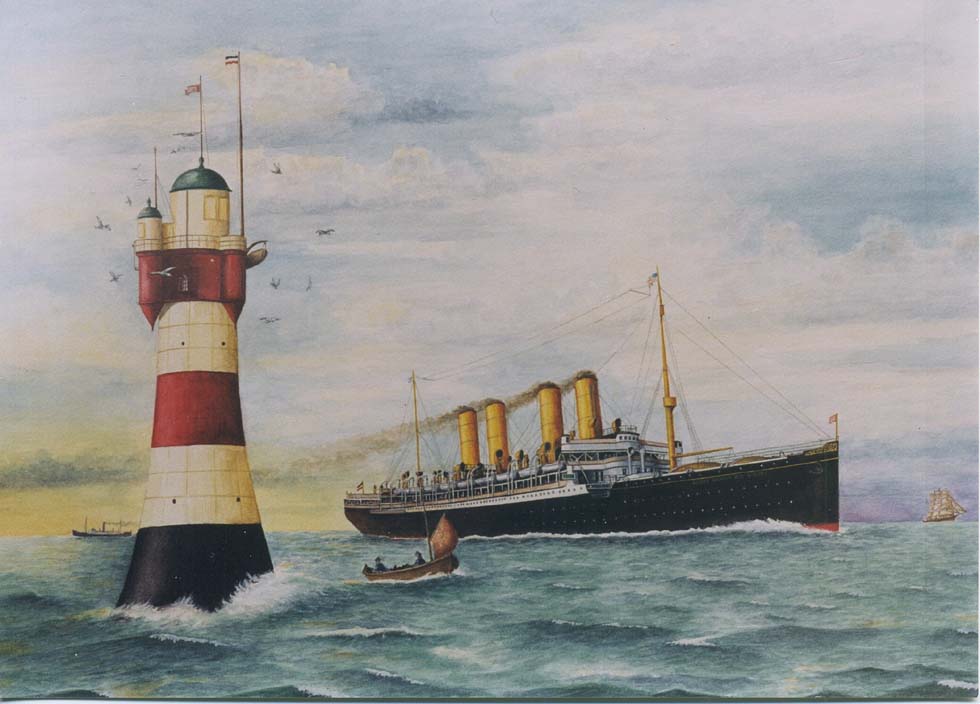
"Kaiser Wilhelm der Grosse", passing Roter Sand lighthouse, a painting by Heribert Schroepfer
The first steamship connection between Bremen and New York was opened in 1847 with the paddle wheel steamer "Washington". Operator was the Ocean Steam Navigation Company, founded by Edward Mills, operating under U.S. mail contract and in association with the Council of the Hansestadt Bremen. Due to a mishandled management, together with an economic crisis in the USA, the Ocean Steam Navigation Company ceased its operation in 1858 and left Bremen without the needed connection to America. To prevent being displaced by Hapag of Hamburg in the North Atlantic business, Bremen's Council acted swiftly and formed on 20 February 1857 the Norddeutscher Lloyd (NDL) with Eduard Cuesemann as its first director. As a first measure a connection was inaugurated to England with three small paddle steamers, "Moeve", "Falke" and "Adler". At the same time orders were placed with British ship yards for four iron-built screw steamers for a transatlantic service. As first left the "Bremen" (2,674 tons) under the Council's flag for New York, soon followed by sisters "New York" (2,674 tons), "Hudson" and "Weser" (2,666 tons each). Profile and equipment followed closely that of the competing Hapag liners, rigged out with auxiliary sails. Lloyd's start was overshadowed by bad accidents. In November 1858 the "Hudson" suffered by fire, the "Weser" in a heavy storm and the "Bremen" was set out of action for 6 months by breaking her screwshaft. Thus, the NDL disposed only upon a single steamer, the "New York", and the company reported serious financial losses.
 "Mosel" of NDL, painting by Chr. Rave (old card, coll. WS)
"Mosel" of NDL, painting by Chr. Rave (old card, coll. WS)
The conditions for the NDL had been greatly improved by the opening of the railway from Bremen to Geestemuende near Bremerhaven in 1862, thus finishing the inconvenient conveyance on open lighters on the Weser due to insufficient depth of the river. The ships of the NDL presented a good standard, but with a crossing speed of 10 to 11 knots they were no match for the larger and faster British and American liners, though some of those had still side-wheel drive. The improved financial situation in the 1860s allowed to order new tonnage. Between 1866 and 1869 the NDL took delivery of six steamers from Caird of Greenock: "Deutschland" (2,947 tons), "Union" (2,880 tons), "Weser" (2,823 tons), "Rhein" (2,901 tons), "Main" (2,899 tons) and "Donau" (2,896 tons), the first three for a traveling speed of 11 the following ones for 13 knots, enabling weekly departures. New compound machinery using superheated steam helped to save much fuel. "Deutschland" sank in the Thames after a collision with the British steamer "Liverpool" in 1875 with 57 victims.
General Director Meier's policy helped the Lloyd to surpass even the Hapag as the principal rival. To consolidate the company's position, orders were placed for 13 steamers of about 3,000 tons of a unified pattern featuring a straight bow and a reduced rigging. For economic reasons, a moderate speed of 12 knots was to satisfy. Thus "Strassburg", "Mosel", "Braunschweig", "Feldmarschall Moltke", "Hohenzollern", "Minister Roon", "Nuernberg", "Hohenstaufen", "Oder", "Neckar", "General Werder", "Salier" and "Habsburg" formed an efficiently operating fleet in the 1870s. "Oder" and "Salier" got lost by grounding, the first in 1887, the other off-shore the North Spanish coast in 1896, taking down with her 480 people.
To catch up with the British rivals, Johann Lohmann, who had followed Meier as General Director in 1877, pursuing the intention not to lose high-fare custom, decided for the introduction of express liners. "Elbe", prototype of a new class of 12 vessels, went on her maiden voyage to New York on 26 June 1881. Her profile was marked by four masts, two funnels and all superstructure concentrated midships, crowned by a sumptuous dining hall with a big cupola above instead of placing it below the upper deck in the rear as usual. A compound machinery, developing 6,230 h.p., made her managing a service speed of 16 knots to complete an Atlantic crossing in 8 days from Southampton. Between 1882 and 1886 she got as partners the "Werra", "Fulda", "Eider", "Ems", "Aller", "Trave", "Saale" and "Lahn", all of 4,700 to 5,000 tons. When in 1890 the "Spree" and the "Havel" of 7,000 tons had taken up service, the NDL disposed upon the largest and most homogenous express liner fleet of the time. The ships won rapidly on popularity and were mostly booked up in advance. While in 1880 60,424 persons were conveyed to New York, their number had grown until 1884 to more than 100,000.
Despite of the encouraging development it could not be ignored that the British liners had reached dimensions of up to 7,400 tons and were crossing at a speed of 18 knots. In 1888 the "City of New York" had surpassed as first the 10,000 ton and the 20 knot limits. Even the next-door rival, the Hapag, had introduced in 1889 twin-screw liners of 7,600 to 8,800 tons starting with the "Auguste Victoria". Towards the end of the 1880s it became more and more obvious that the NDL had missed the connection. Maintaining still the first place in the North Atlantic passenger business, it could not be overlooked that Great Britain's merchant fleet disposed upon 5,471 ships totaling 5,369,952 gross tons against 761 German vessels totaling 762,915 tons. Nevertheless, during the decade from 1881 to 1891, 738,668 persons arrived at New York on board of a NDL-liner, 525,900 took the Hapag and only 371,193 decided for the White Star Line, followed by Cunard and Inman on the fourth and fifth place counting 323,900 resp. 322,900 voyagers.
Liners of Prestige
After the loss of "Eider" and "Elbe" in accidents, the Lloyd had 9 express liners in operation. But these could no longer been considered first choice. The year 1897 marked the beginning of a new era in Germany's navigation. The completion of the locked Kaiserhafen combined with the deepening of the fairway to the Weser mouth paved the way for the inauguration of larger ships. In the preview of this advance, orders had been placed in 1895 for two liners of a completely new style, one with the Vulcan shipyard of Stettin, the other with Schichau of Danzig. To maintain the Lloyd's position on the North Atlantic, something better than the River Class would be needed. According to specifications the ships were expected to perform an Atlantic crossing in less than 6 days at an average of 21 knots. Two years after commission the Vulcan reported its vessel ready for launch. The ceremony became a national event. In presence of 30,000 spectators the ship was christened by the Emperor on the name of his grandfather, "Kaiser Wilhelm der Grosse", first monarch of the German Empire of 1871. Chief naval architect was Max Walter, the interiors being styled by Johann G.Poppe. Apart of a stranding on a sandbank, the yard trials showed throughout positive results, so that the maiden voyage could be fixed for the 19th September 1897. That date initiated the decade of German supremacy. Measuring 14,349 tons, the "Great Kaiser" as the ship used to be called, entered service as the largest of the time and as the first German one winning the Blue Riband, managing 22,35 knots eastward on the classical racing route between Sandy Hook and Bishop Rock in November 1897. She was also the first featuring four funnels (put up in pairs), thus symbolizing the new era. Her triple expansion compound machinery, developing 31,000 h.p., worked on two screws. But only three years later she lost the trophy to Hapag's "Deutschland" which attained 22.2 knots westbound.
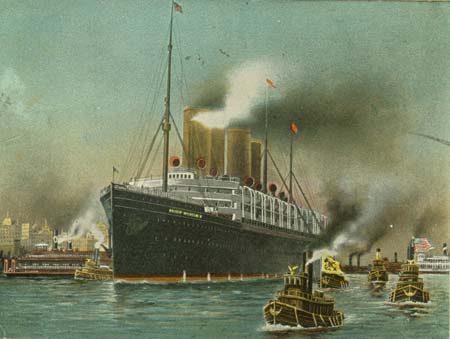
"Kaiser Wilhelm II" arriving at New York (old card, coll. WS)
|
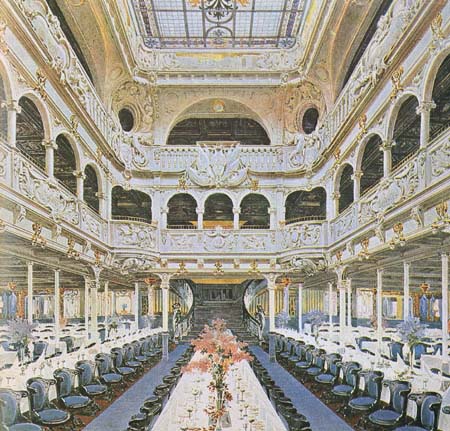
"Kaiser Wilhelm II", NDL (advertisement Hapag-Lloyd)
|
In October 1897 the NDL had taken delivery of the other, Schichau-built liner, urgently needed as route-mate to the "Kaiser". Although laid out at only 12,481 tons, the builder had promised to cope with the specifications but at a higher degree of economy. After three Atlantic crossings it became evident that the three-funneled "Kaiser Friedrich" - so the name of the ship - would never keep pace with the expected task. Despite of several improvements of her machinery she attained hardly 20 knots. Disappointed of the results, the NDL returned the ship to the builder yard because of failing the conditions of the contract. After a trifle of test voyages in charter of the Hapag the ship was laid up at Hamburg. Eventually in 1912 the Sud-Atlantique of Bordeaux showed interest in a purchase and renamed her "Burdigala".
Unlike the Hapag, the NDL based its policy further on upon express liners. As counterparts to White Star's "Oceanic" and to get route-mates for the "Kaiser Wilhelm der Grosse", enabling weekly departures, orders for two other liners were placed with the Vulcan. Until their completion the Lloyd had to get on with the modernized "Spree", renamed "Kaiserin Maria Theresia", now fitted with twin-screw drive and a third funnel.
While in 1897 11,583 cabin passengers and 24,562 emigrants had booked for an Atlantic passage on a Lloyd ship, the number had risen within one year to 58,223. Approximately 24 percent of the persons having arrived at New York sailed under the Lloyd flag. When in 1900 the Hapag had introduced the bigger and faster "Deutschland", the NDL had to fear for its position and prestige. Everything changed even to the worse by a fire catastrophe at New York Harbour in 1900 which expanded rapidly and destroyed four of its liners docking there. "Kaiser Wilhelm der Grosse" escaped in last minute suffering only minor damages. Urgently was p laced an order with the Vulcan for a new premier liner, ready for launch on 30 March 1901 named "Kronprinz Wilhelm". On 17 September 1901 she went on her maiden voyage to New York. Her design followed in general that of "Kaiser Wilhelm der Grosse" at a size of 14,908 tons. Her 33,000 h.p. machinery gave her a traveling speed of 23 knots. An important innovation in matter of safety was the fitting of automatically closing bulkheads operated from the bridge. Unlike the "Deutschland", the "Kronprinz Wilhelm" had no trouble with vibration. Incidentally she bate her Hapag rival by 0.03 knots, however sufficient to regain the Blue Riband for the Lloyd, and her raised comfort helped to attract particularly rich Americans.
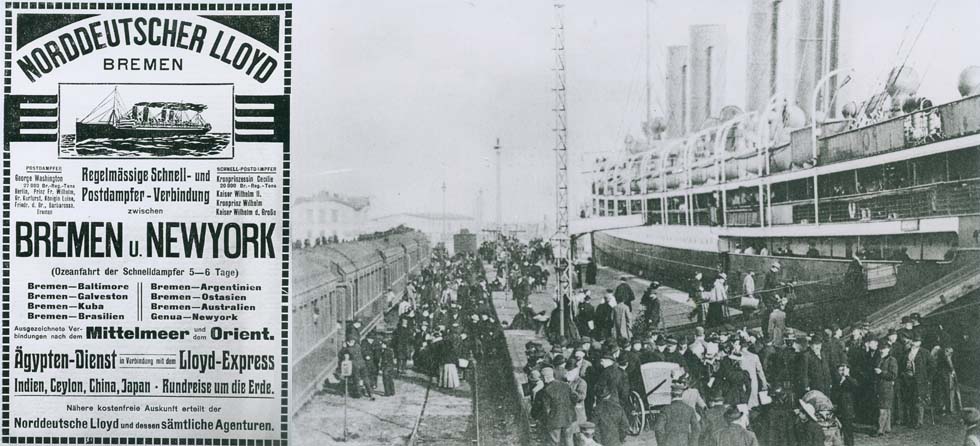
NDL advertisement (Reichskursbuch); "Kaiser Wilhelm der Grosse" and an 'Ozeanzug' at Bremerhaven (coll. Roger Commault)
The NDL, anxious to maintain its ranking as world's first passenger shipping company, needed further tonnage for its express service. Launched in 1902 and christened "Kaiser Wilhelm II", a new crack liner, 3,000 tons larger than the "Kaiser Wilhelm der Grosse", joined the fleet. It took her however three years until beating the "Deutschland", attaining 23,58 knots west bound, just by a surplus of 0.07 knots in 1906. With a third mast mounted on the upper deck, her profile appeared less graceful than that of the forerunners. Her public space however, designed by Poppe, marked NDL's highlight in neo-baroque styling. In August 1907 she got a sister, "Kronprinzessin Caecilie".
In the meanwhile a revolutionary change took place in matters of ship propulsion, when Cunard got going the turbine-powered super liners "Lusitania" and "Mauretania", surpassing the tonnage of the last Lloyd liners by a third, ploughing at more than 25 knots through the Atlantic. With the last two Lloyd liners, the reciprocating steam engine had reached the final stage of development delivering 44,000 h.p.. A project of 1902 by Johann Schuette for a 20,000-ton liner featuring five funnels was no longer pursued. The four-funneled runners marked a climax in design, comfort and weekly departures.
The four express liners had contributed essentially to the Lloyd's prestige. The profits they brought in were however not proportional to the immense expenses their operation demanded. Director Wiegand, impressed by the successful operation of the medium-speed liners like White Star's "Celtic" and Hapag's "Amerika" class, decided to follow that strategy and awarded contracts for 3 ships resembling that pattern with the Tecklenborg AG, the Weser AG and the Vulcan. As first was available for operation the Tecklenborg-built "Prinz Friedrich Wilhelm" of 17,082 tons. Her two thin funnels, framed by two masts, gave her a somewhat antiquated profile which was however upgraded by her excellent comfort. Twin quadruple compound engines acting on two propellers producing 14,500 h.p. - one third less than the output of the "Kronprinzessin Caecilie" - enabled her after all to manage 17 to 18 knots. In 1909 the NDL took delivery of the quite similar "Berlin" of 17,323 tons from the Weser AG. Soon after her maiden voyage to New York she was transferred to the Lloyd's Mediterranean route departing from Genoa. The third vessel of the new pattern, delivered from the Vulcan, named "George Washington", entered service on 2nd June 1909 and was by a third bigger than her forerunners, measuring 25,000 tons and disposing upon a speed potential of 18.5 knots. She was the expected trump card to catch fully up with the competitors. In spite of her reinforced machinery, the fuel consumption remained far behind of that of the race horses. Apart from the greatly admired comfort of the cabin classes, the ship became also first choice for emigrants offering improved accommodations.
WWI and Aftermath
Started as a pacemaker, "Kaiser Wilhelm der Grosse" was downgraded to an austere emigration ship. When war broke out in 1914, she was fitted as an armed merchant cruiser. Her Achilles Heel, the extreme fuel consumption, led to her rapid end on 26 August 1914 after a military career of only 3 weeks by a surprising attack of the British cruiser "Highflyer" during coaling off Rio d'Oro, Spanish West Africa. "Kronprinz Wilhelm" was confiscated in 1917 in the USA. Renamed "Steuben", she was employed in military duties and scrapped at Boston in 1923. "Kaiser Wilhelm II" shared the same fate having become USS "Agamemnon" in 1917. Renamed "Monticello" in 1919, she went to the shipbreaker at Boston in 1940. The "Kronprinzessin Caecilie" served as "Mount Vernon" the U.S. Navy and was broken up at Boston, too.
"Prinz Friedrich Wilhelm" was surprised by the outbreak of war during a Northland cruise. 1916 she returned from Norway. In 1920 she became the "Empress of China" of the Canadian Pacific Line. Name changes followed in "Empress of India", "Montlaurier", "Monteith" and "Montnairn". She went in 1929 to Genoa for scrapping. "George Washington" was confiscated at New York in 1917 and equipped for trooping duties. After sailing in charter of the U.S. Mail lines in the 1920s, she returned to her commercial employment on the Bremerhaven - New York route under the flag of the United States Lines. Laid up from 1931 to 1940, she was re-activated for military duties as USS "Caltin". Converted to oil-firing and with one funnel removed, she was given back her old name. Suffering twice by fire, she went to the ship breaker at Baltimore in 1951.
Despite of the total loss of all ocean-going passenger ships, the NDL strove to return to its North Atlantic trade. The first vessel to resume this service was the "Seydlitz" of 1903 (7,964 tons) of the former East Asia route, which docked at New York on 12 November 1921. She was released from delivery by the Columbus Contract.
Competition on the North Atlantic grew stiffer and the NDL could no longer withstand the challenge with the aging express liners. Despite of being hard up, orders for two liners of more than 30,000 tonnage were placed with the Schichau AG, rooting in the reputation of the Lloyd for solid comfort and superb design to restore the company's distinctive policy. The "Columbus", launched in 1914, was still uncompleted when war stopped further equipment work. Her sister, "Graf Zeppelin", (name later changed to "Hindenburg") had to be laid up. According to the Peace Settlements, Germany had to deliver all merchant vessels of more than 1,600 tons to the Allied Shipping Board, including those still under construction at German shipyards. Danzig, base of the Schichau AG, had been declared a Free Municipal District and refused to hand over the uncompleted ship. In a lawsuit an agreement was made that Schichau would complete the ship (which became the later "Homeric" of the White Star Line). In countermove the contract for the other one could be executed for the Lloyd (Columbus Contract of 5 August 1921). Over and above, six of the Lloyds smaller pre-war ships were released from delivery. The launch of the big liner took place on 22 August 1922, giving again the name "Columbus". As the new flagship of the NDL, the 32,354-ton liner took up service in the company's distinguished manner in August 1924, ten years after laying the keel. Although not crowned with superlatives, the "Columbus" was one of the most appreciated liners of the time, featuring a maximum of comfort, her interiors being styled by architect Paul Troost. Her regular service was occasionally interrupted when chartered for cruises. Special fame she gathered with well-situated Americans on circumnavigation tours, then having her hull painted white. During an Atlantic crossing her starboard screwshaft got broken. This event was taken for occasion to replace the outdated steam engines of pre-war design by geared turbines raising the power from 28,000 to 49,000 h.p. and her speed from 18 to 23 knots. Until the installation of the new machinery, a shaft from a cargo steamer was fitted in. The ship re-entered service in 1929, equipped with shorter funnels in order to follow the appearance of the super liners in prestigious North Atlantic services. The "Columbus" was surprised by outbreak of war during a Caribbean cruise. After disembarkation of the tourists at Havana, she had order to break through the British blockade to Germany. On 19 December 1939 she was stopped by the destroyer "Hyperion". To avoid capture, order was given to sink the ship by opening floodwalves and setting her on fire. The crew was taken up by the U.S. cruiser "Tuscaloosa" close by and the men were allowed to stay in the USA as immigrants, though the Nazis tried to prevent it.
"Bremen" and Europa"
Germany went through hard times after the lost war. Not only suffering under the hardship of the peace treaty, the country was afflicted by the dissents of the political parties culminating in street battles, mega inflation, a paralysed economy, mass-unemployment and famine. It was not until the stabilization of the currency that the NDL could think of new tonnage. The Germans did all they could to regain their lost national self-esteem in putting up technical top performances: the airship "Graf Zeppelin" and Dornier's flying boat Do X (powered by 12 engines) had made worldwide headlines, the sumptuous "Rheingold" express appeared as the last word on rail and the extravagant motor cars of Daimler-Benz and Maybach found enthusiastic echo with motor fans, not to speak of the rapid spreading of broadcast and cinema, to mention only a few of the impressive creations of the 1920s. Under this aspect the navigation could not stay away, convinced of the fact that only ships featuring a completely new style would ensure to master the future.
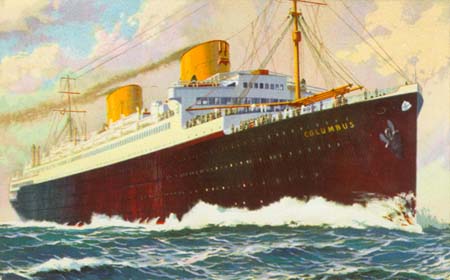
"Columbus" after modernization (old card, coll. WS)
|
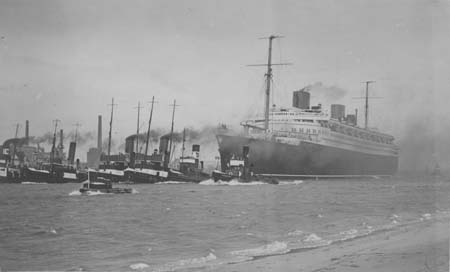
"Bremen" (old card, coll. WS)
|
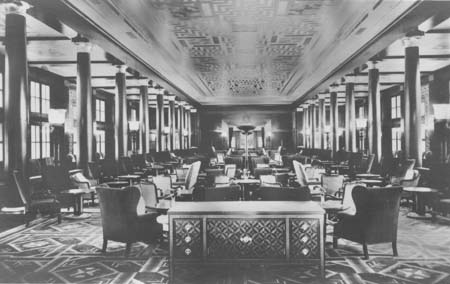
"Europa", 1st class (old card, coll. WS)
|
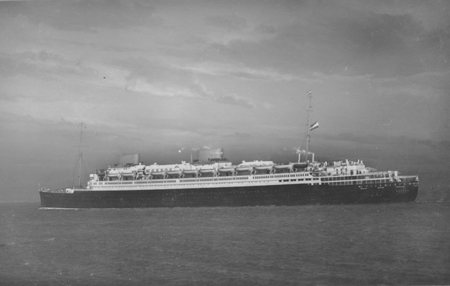
"Europa" (old card, coll. WS)
|
In 1926, Director Glaessl, the new head of the NDL, signed contracts for 2 super liners, one with the Weser AG of Bremen, the other with Blohm & Voss of Hamburg. The orders were favoured by the decision of the American Congress to remake payments for the requisition of German ships during the war. The new ships were of an innovative design, created mainly by Dr. W. Suechting. 14 months after laying the keel, the first crack liner was launched in presence of Reichspraesident Hindenburg at the Weser shipyard and christened on the name of "Bremen". On 5 July 1929 she went on her maiden voyage from Bremerhaven to New York and surprised by an appearance never seen before, marked by streamlining, starting with the curved bow and bridge-house, the two extremely short oval funnels and the all around elegant proportions. The modern appearance of the ships corresponded with an interior in the new "Ocean liner" style, designed by famous architects Fritz August Breuhaus for the "Bremen" and by Paul Troost for the "Europa". With a tonnage of 51,656, the "Bremen" offered accommodation for c.2.000 passengers in three comfortably furnished classes.
Her partner, the "Europa", measuring 49,746 tons, followed the same general pattern. Both ships were intended to initiate a weekly service from Bremerhaven to New York on 1st April 1929. But during the equipment works a disastrous fire destroyed vast areas of the ship. Thus the envisaged operation was delayed until 22 February 1930. Both ships had been far ahead of their time. As notable innovation should be mentioned the slightly bulbous bow beneath the waterline, providing a dynamic sliding, inspired by U.S. Navy ships designed under Admiral Taylor. The airplane sent off from a catapult on the upper deck was to reduce the intercontinental mail transport to 3 days, a service abandoned in 1935. Both ships broke on their maiden voyages the record of the "Mauretania". The "Bremen", heading west, managed 27.83 knots, eastward 27.92 knots, later improved to 28.61 knots. The "Europa" attained under bad weather conditions 27.91 knots westbound. Initially the ships docked in New York at Brooklyn pier, from 1934 at the extended Manhattan Pier 86. In Cherbourg in the same year a new terminal replaced the tender-shuttle. Both ships took turns in the possession of the Blue Riband until 1933, when they had to leave the trophy to the Italian "Rex".
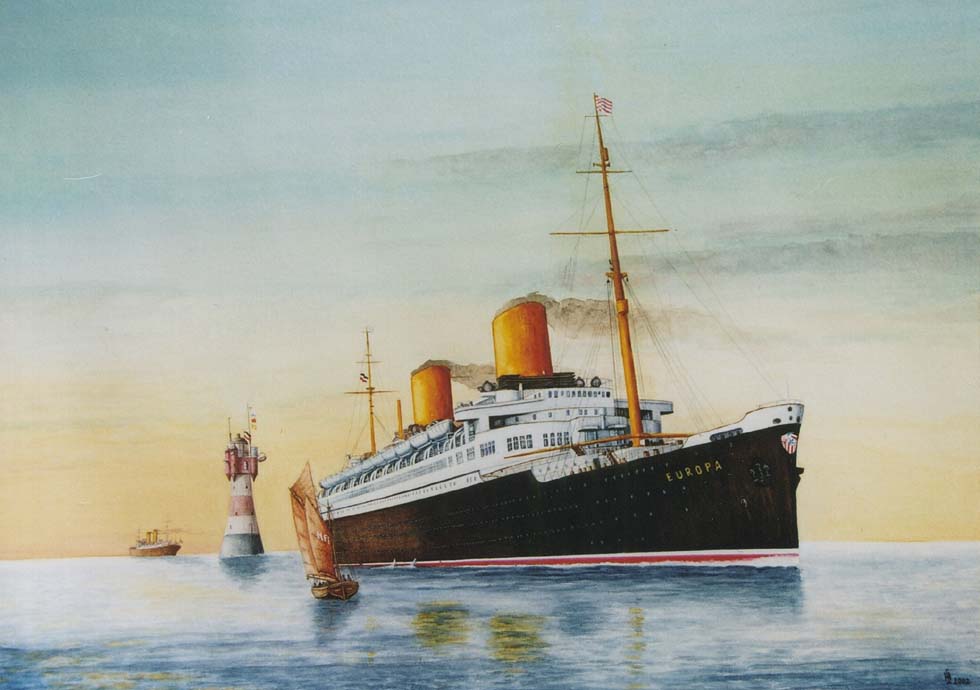
"Europa", entering the mouth of the Weser (painting by Heribert Schroepfer)
 "Bremen", funnels refurbished (painting by Heribert Schroepfer)
"Bremen", funnels refurbished (painting by Heribert Schroepfer)
The race for the fastest and largest ships continued with the "Queen Mary" and "Normandie", to be followed by the "Queen Elizabeth" and a French "Bretagne". Contrary to the "Bremen" and "Europa", the "Normandie" was financed by the taxpayers, ignoring the fact that business travelers would change to plane in a foreseeable future. While Hapag concentrated on a project of relatively moderate 41,000 tonners, the NDL together with the AG Weser shipyard developed in 1937 the project of an 80,000-ton megaship, to be subsidized by politics, with c.300,000 hp, 5 screws and a maximum speed of 35 knots capable of winning the Blue Riband. Historian Arnold Kludas presumed different design studies, one with a length over all of 328 m, a beam of 34 m and a capacity of 2,000 passengers. A published drawing showed a beautiful liner with a Maier bow, cruiser stern and a single wide, short funnel. Contrary to the more realistic "Vaterland" of Hapag, the ship was never commissioned. Kludas supposed that the Minister of Transport Dorpmueller favoured the project, Admiral Raeder of the navy rejected it in favour of a North Atlantic battleship fleet and Hitler had not yet decided. The name "Amerika" or "Viktoria" remained a fantasy.
Other Companies
As mentioned with the previous chapter, Robert Miles Sloman had pioneered the German steam navigation, years before Hapag and Lloyd started their operations. America's economic recovery after the Civil War was followed by an immense increase of emigration from Europe. To cope with, the NDL formed in 1857 a joint venture with the Baltimore & Ohio Rail Road to run a Bremerhaven - Baltimore service with the shipping operation in the hands of the Lloyd using the four small steamers "Baltimore", "Berlin", "Ohio" and "Leipzig". Growing deficits in the 1870s forced to close down that business. The 4 steamers were thereafter engaged in the cargo trade of the Lloyd.
Just as little successful remained the operation of the Bremer Dampfschiffahrts-Gesellschaft of 1871. After seven Atlantic crossings with the small steamer "Schmidt" the operation was given up. Businessmen of Stettin turned their attention to the growing stream of emigrants from Eastern Europe heading to the New World and formed in 1870 the line Baltischer Lloyd. Five small steamers, "Humboldt", "Franklin", "Thorwaldsen", "Ernst Moritz Arndt" and "Washington" were specialized in low-fare custom embarking at Stettin for New York with calls at Copenhagen and Christiansand (now Kristiansand, Norway), proceeding north of Scotland. A crossing took approximately three weeks. In 1871 the first year of operation, a bad cholera epidemic erupted aboard the "Franklin", claiming 41 victims. Immense loses in the cargo trade led to bankruptcy and to the sale of the ships in 1874.
Even less successful was the endeavour of the Deutsche Transatlantische Dampfschiffahrts-Gesellschaft, better known as the Adler Linie, founded in 1872. First sailing to New York started "Goethe", followed in November 1873 by "Herder", "Schiller", "Klopstock", "Wieland" and "Gellert" (all named after poets of the German classical period). Despite of well-designed ships, superior to those of the Hapag and the Lloyd, the line proved not being able to cope with the mighty competitors. To prevent the imminent bankruptcy, the management decided for the merger with Hapag in 1873. In the same year "Schiller" run aground at the Scilly Islands with 312 losses.
Six years after the Baltic Lloyd, another attempt was started to establish a steamship connection from Stettin to New York by Captain Carl Schultz. As the first, "Kaethe" of 2,700 tons went on her maiden voyage for the Stettiner Lloyd on November 1880. She was given a partner in 1884, the "Martha" of 2,100 tons. Also this enterprise was sentenced to fail and ceased operation after bankruptcy in 1886. The line's operation was continued by the Hapag.
Somewhat better worked the Hamburg - Canada operation of the Dampfschiff-Reederei Hansa, formed in 1882, disposing upon a fleet of 12 unobtrusive steamers of about 2,000 to 3,000 tons. Despite producing good revenues in 1888/89, the line could not withstand Hapag's policy of expansion having thrown an eye on the company's Canada service. In a contract of 1892 the Hapag was authorized to continue the operation under the name Hansa Linie, widened by an extension to Boston.
In 1935 the ship owner Arnold Bernstein signed a contract with the Ford Motor Company for car transportation to Europe which was extended to American tourists who wanted to have their car with them. Bernstein, who had acquired the Red Star Line from the Chemical Bank & Trust Co. of New York, purchased 5 steamers second-hand from British owners to have them refurbished with passenger accommodations and facilities for car transport as well. The ships, "Ilsenstein", "Gerolstein", "Koenigstein", "Pennland" and "Westerland", worked effectively between Le Havre and New York. The acquisition was favoured by the Council of Hamburg. But due to the anti-Semitic laws of the Nazi government, Bernstein wrongly was charged of a financial offence and sent to prison. The two big ships went to the Holland America Line, "Koenigstein" was sunk as "Gandia" (CNB Line) in 1942, the two others were scrapped in 1939.
World War II
Already before the 80,000-ton superliner was commissioned for Norddeutscher Lloyd and even before the battleship fleet was built, Hitler decided for war. After he started it by invading Poland in September 1939, the "Bremen" of NDL, avoid of passengers, broke through the British blockade running from New York to Murmansk in the Soviet Union, which was not yet involved in war. From there she reached safely her homeport. Used as a hulk, she burnt out completely on 16 May 1941 by arson. She was intended to take part in the planned invasion of England as a troop transport. Partner "Europa" spent the war as a hulk for navy personnel. The intended conversion to an auxiliary aircraft carrier had been given up. After the war she was used as U.S. troopship and thereafter handed over to France. As "Liberte" she served the Le Havre-New York route of the CGT. In 1962 she was released by the new "France" as flagship and set to La Spezia for scrapping.
Four other ships of much smaller dimensions had joined the Lloyd fleet in the 1920s: "Muenchen" (13,325 tons), "Stuttgart" (13,327 tons), "Berlin" (15,268 tons) and "Dresden" (14,690 tons). The "Muenchen", after fire reconstructed and renamed "General von Steuben", was used from 1935 for cruises. On an evacuation transport she was sunk in the Baltic Sea by a Soviet submarine on 2 February 1945 with more than 3,000 losses. "Stuttgart" was destroyed by an air attack. "Berlin", from 1934 to 1939 operating for the KdF organization, was hit by a boiler explosion causing 17 victims of the crew. Temporarily fitted as a hospital ship during the war, she started a new career as "Admiral Nakhimov" for the Black Sea Shipping Company of Odessa. She sunk after a collision with a Russian tank ship.
After World War II
When World War II had ended on 8 May 1945 on the European theater, Germany laid down in agony. The country, occupied by the armies of the victorious powers, was hermetically divided in occupation zones. The majority of the German merchant ships has gone into the war and those which had survived were confiscated for reparations. In spite of the desperate situation, the NDL ventured on the difficult task of a restart. As soon as the Allied Control authorities had relaxed their restrictions, the NDL contracted in 1950 the Svenska Amerika Linjen. This way, the Bremen-Amerika Linie was founded. In 1954 the old motor ship "Gripsholm" of 18,600 tons, making 16 knots white-painted with buff Lloyd funnels, resumed the traditional transatlantic service under the new German national flag in black, red and gold. The ship had operated during the war for the International Red Cross. Modernized and renamed "Berlin", she went into the full ownership of the NDL in 1955 and was kept in operation until 1966, then having completed a career of 41 years.
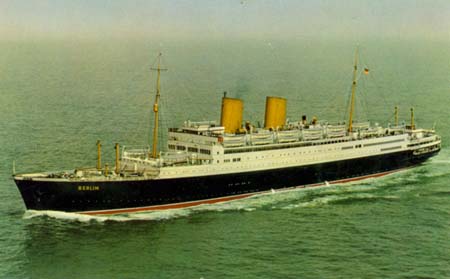
"Berlin" ex "Gripsholm" (old card, coll. WS)
|
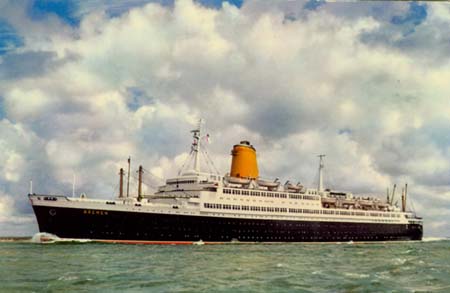
"Bremen" ex "Pasteur" (coll. WS)
|
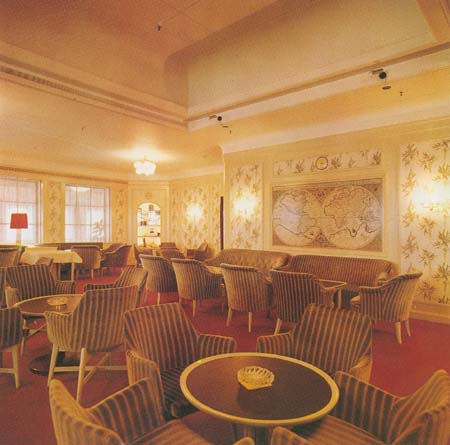
"Europa" ex "Kungsholm", the "Columbus C" (old Costa ad, coll. WS)
|
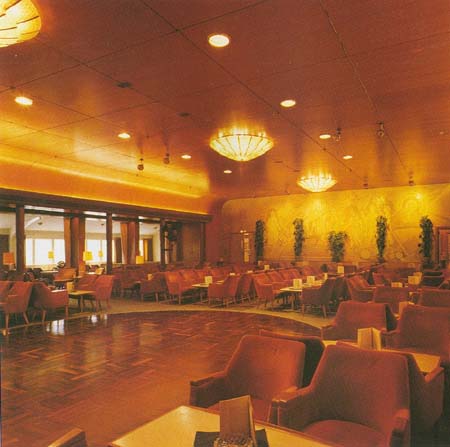
"Europa" ex "Kungsholm", then "Columbus C" (old Costa ad, coll. WS)
|
Despite of the good booking accounts of the "Berlin", there could be no doubt about, that she was not more than a temporary solution. If the NDL was to play a major part in the North Atlantic passenger trade, it would need a ship of much larger dimensions. With regard of the enduring financial difficulties, only a second-hand vessel came into consideration. The change came in 1957, when the French government put up for sale the troopship "Pasteur" of 30,447 tons. The four-screw liner was commissioned in 1939 for the Compagnie Sudatlantique of Bordeaux with the Penhoet yard of St. Nazaire, but instead of taking up her provided South Atlantic service she had to serve as a troopship, at last in the Indochina conflict. After thorough reconstruction, the ship started a new career as the "Bremen" of NDL and flagship of the revived German merchant navy. On July 1959 she went on her inaugural voyage from Bremerhaven to New York, calling at Southampton and Cherbourg, but was temporarily engaged in cruises. Having given a new coned funnel and two short whip-shaped masts she presented the typical pattern of liner of the time. Her geared turbines developed 60,000 h.p. and, acting on 4 propellers, helped to manage 23 knots. Following the decline of bookings, she was sold in 1972 to the Chandris Lines of Piraeus, then running as "Regina Magna", and was finally used as the hulk "Saudiphil" of the Philippines Singapore Ports Corporation for migrant workers. She sank on the transfer to Hong Kong in the Gulf of Aden in 1980.
To replace the aging "Berlin", the NDL purchased in 1965 from the Svenska Amerika Linjen the motor ship "Kungsholm" (1953/21,511 tons), built at the Schelde N.V. of Flushing (Vlissingen). She performed service on the Gothenburg - New York route. Her twin-screw diesel machinery, developing 14,700 h.p., made her managing 19 knots. Not intended as a record breaker, she presented with her well-proportioned outlines with two slightly inclined buff funnels and white livery a ship of grace and up-to-date comfort. Renamed "Europa" (III) she entered Lloyd service on 9 January 1966. From 1972 she was exclusively engaged in cruises. In 1981 the "Bremen" became "Columbus C." of Costa Crociere and was broken up at Cadiz in 1985. The rapid decline of passenger bookings led to the retirement of the NDL from the liner service.
It was obvious that Hamburg as Germany's most important port was interested to base again a passenger operator on the North Atlantic. The Greek Eugen Eugenides, owner of the Home Lines (see chapter Mediterranean-America), and the Danish shipping agent Bitsch-Christensen formed on 6 January 1958 the Hamburg-Atlantik Linie. They purchased from the Canadian Pacific Steamship Co. the three-funnel liner "Empress of Scotland" (26,313 tons, built in 1929) and having her thoroughly modernized and re-engined for a speed of 21 knots, they initiated a new New York service from Hamburg. The ship, now measuring 30,029 tons and featuring two short inclined funnels, had started her career as "Empress of Japan" of the CP with a Liverpool - Vancouver maiden voyage and was transferred onto the Vancouver - Yokohama route. Renamed "Empress of Scotland", she spent the war years as a troop ship. In 1950 she resumed her commercial operation between Liverpool and Quebec. The "Hanseatic" was popular as liner and cruise ship as well until she suffered by a fire in 1966. Towed back to Hamburg, she was broken up the same year. The company, later Deutsche Atlantik Linie, continued offering cruises - see chapter Cruises/ German Tradition.
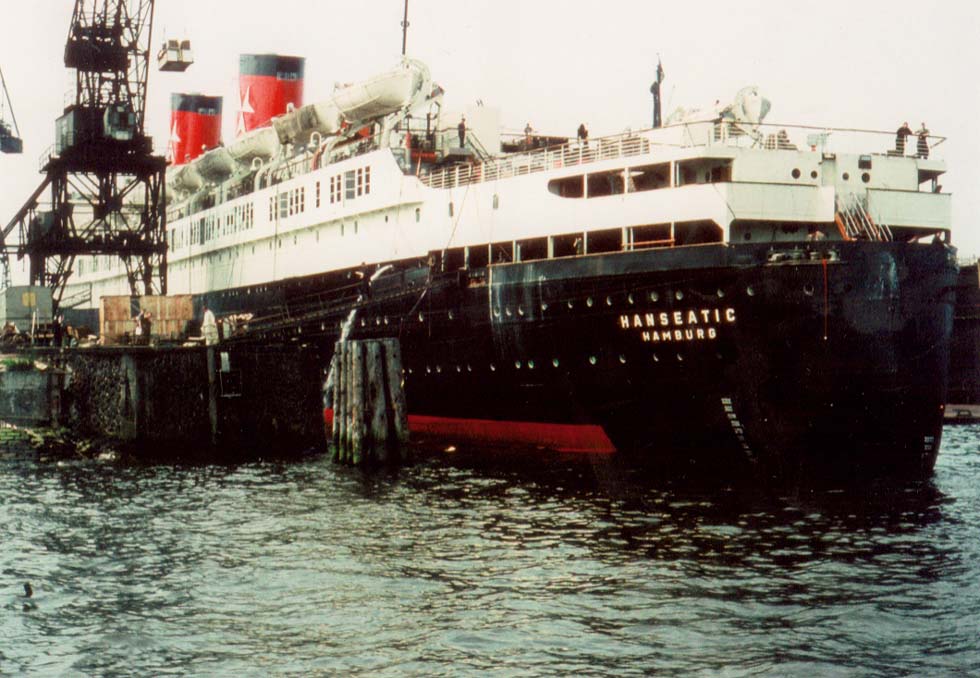
"Hanseatic" during reconstruction at Hamburg (Anton Schroepfer)
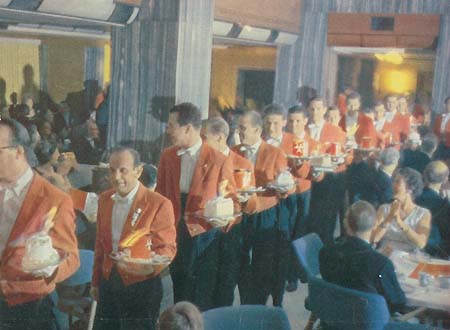
"Hanseatic" (contemporary press, WS)
|
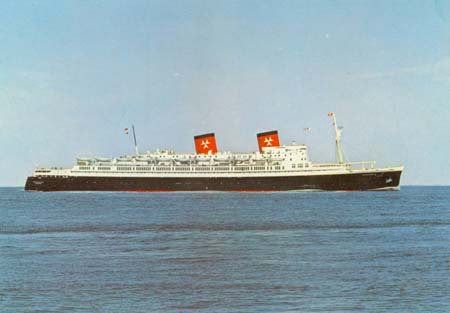
"Hanseatic" (old ad card, coll. HSch)
|
|